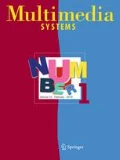Abstract
Programming, testing, and maintaining interactive multimedia applications (IMAs) are still difficult and expensive, while substantial progress has been made to reduce the burden on authors. As IMAs get larger and more complex the difficulties will increase. To overcome the complexity of such IMAs, we argue that authoring systems should provide such facilities as (1) a traditional and intuitivedivide-and-conquer paradigm for solving large and complex problems in various fields, (2)formal specification of the behaviors of IMAs for checking the syntactic correctness of visual expressions or semantic anomalies, and (3)automatic aids like validation of temporal constraints and verification of visual expressions. In this paper, we investigate the properties of IMAs for recognizing the inherent interactivity and concurrency. We propose a specification method based on Milner'sCalculus of Communicating Systems (CCS), which is a well-known formal mechanism for specifying the concurrency in various distributed applications. We also design and implement an authoring system calledEventor (Event Editor), which is based on CCS and composed of three tools: a Temporal Synchronizer, a Spatial Synchronizer, and a User Interaction Builder. They focus on describing the temporal and spatial synchronizations and user interactions while they rely on existing tools in Intel's Digital Video Interactive (DVI) for supporting other functionalities. By editing a simple computer aided instruction (CAI) application, we illustrate that our specification mechanism is well-suited for handling the interactivity of multimedia applications, and Eventor is a simple, efficient, and powerful enough tool to handle practical applications. Especially the incremental refinement and the formal specification based on the CCS allow Eventor to be extended with formal verifications to cope with large and complex applications.
Similar content being viewed by others
References
Ambron S, Hooper K (eds) (1990) Learning with interactive multimedia, Microsoft Press, Apple Computer, Redmond, USA
Anderson CJ, Veljkov MD (1990) Creating interactive multimedia: a practical guide. Scott, Foresman, London, UK
Buchanan MC, Zellweger PT (1993) Automatic temporal layout mechanisms. Proceedings of ACM Multimedia 93, Anaheim, CA, USA, pp 341–350
Coolahan JE, Roussopoulos N (1983) Timing requirements for timedriven systems using augmented Petri nets. Trans Software Eng 9:603–616
Fujikawa K (1991) Multimedia presentation system “Harmony” with temporal and active media. Proceedings of the Summer 1991 USENIX Conference, Nashville, pp 75–93
Gibbs S (1991) Composite multimedia and active objects. Proceedings of ACM Conference on Object-Oriented Programming Systems, Languages, and Applications, New York, pp 97–112
Hardman L (1993) Structured multimedia authoring. Proceedings of ACM Multimedia 93, Anaheim, CA, USA, pp 283–289
Herrtwich RG (1990) Time capsules: an abstraction for access to continuous-media data. Proceedings of Real-Time Systems Symposium 6:11–20
Hodges ME, et al. (1989) A construction set for multimedia applications. IEEE Software, Intel Corporation, Santa Clara, CA, USA, 37–43
Intel Corp (1991) ActionMedia 750 Reference Manual ISO
ISO/IEC (1987) Information retrieval, transfer and management for OSI —LOTOS —a formal description technique based on the temporal ordering of observable behaviour. International Standard, ISO–8807
ISO/IEC CD 13522-1 (1993) Information technology —coded representation of multimedia and hypermedia information objects (MHEG) —Part 1: Base Notation (ASN.1). International Stan-dards Organization, ISO
Kim HC, Eun S, Yoon H, Maeng SR (1992) Data abstractions for multimedia composition and synchronization. Proceedings of 2nd Pacific Rim International Conference on Artificial Intelligence, Seoul, Korea, pp 1079–1085
Little TDC, Ghafoor A (1990) Synchronization and storage models for multimedia objects. IEEE Selected Areas Commun 8:413–427
Little TDC, Ghaffor A, Chen CYR (1992) Conceptual data models for time-dependent multimedia data. Proceedings of multimedia information systems workshop, Tempe, AZ, USA, pp 86–110
Luther AC (1989) Digital video in the PC environment. 2nd edn., McGraw-Hill
Milner R (1989) Communication and concurrency. Prentice Hall No ES (1992) Eventor: a visual programming environment for build-ing interactive multimedia applications. MS Thesis, Dept. of Computer Science, Korea Advanced Institute of Science and Technology, Taejon, Korea
Stasko JT (1991) Using direct manipulation to build algorithm anima-tions by demonstration. Proceedings of the CHI'91 Conference, pp 307–314
Steinmetz R (1990) Synchronization properties in multimedia systems. IEEE J Selected Areas in Commun 8:401–412
Stevenes SM (1989) Intelligent interactive video simulation of a code inspection. Commun ACM 32:832–843
Suchi A, Siochi A, Fox EA, Schwartz EE (1991) The integrator: a prototype for flexible development of interactive digital multimedia applications. Interactive Multimedia 2:5–26
Ziegler R (1992) Multimedia tools for development pros. Datamation, 90–95
Author information
Authors and Affiliations
Corresponding author
Rights and permissions
About this article
Cite this article
Eun, S., No, E.S., Kim, H.C. et al. Eventor: an authoring system for interactive multimedia applications. Multimedia Systems 2, 129–140 (1994). https://doi.org/10.1007/BF01222125
Issue Date:
DOI: https://doi.org/10.1007/BF01222125




